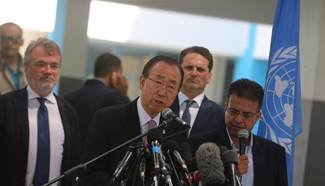UNITED NATIONS, June 28 (Xinhua) -- The UN Children's Fund (UNICEF) on Tuesday said that 69 million children under five will die from mostly preventable causes, 167 million children will live in poverty, and 750 million women will have been married as children by 2030, the target date for the Sustainable Development Goals.
The UN agency compiled the report based on the basis of the current trends, urging the world to focus more on the plight of its most disadvantaged children.
"The State of the World's Children," UNICEF's annual flagship report, painted a stark picture of what is in store for the world's poorest children if governments, donors, businesses and international organizations do not accelerate efforts to address their needs.
"Denying hundreds of millions of children a fair chance in life does more than threaten their futures -- by fueling intergenerational cycles of disadvantage, it imperils the future of their societies," said UNICEF Executive Director Anthony Lake. "We have a choice: Invest in these children now or allow our world to become still more unequal and divided."
The report noted that significant progress has been made in saving children's lives, getting children into school and lifting people out of poverty.
Global under-five mortality rates have been more than halved since 1990, boys and girls attend primary school in equal numbers in 129 countries, and the number of people living in extreme poverty worldwide is almost half what it was in the 1990s.
But this progress has been neither even nor fair, the report said. The poorest children are twice as likely to die before their fifth birthday and to be chronically malnourished than the richest.
Across much of South Asia and sub-Saharan Africa, children born to mothers with no education are almost three times more likely to die before they are five than those born to mothers with a secondary education. And girls from the poorest households are twice as likely to marry as children than girls from the wealthiest households.
Nowhere is the outlook grimmer than in sub-Saharan Africa, where at least 247 million children -- or two in three -- live in multidimensional poverty, deprived of what they need to survive and develop, and where nearly 60 percent of 20-to 24-year-olds from the poorest fifth of the population have had less than four years of schooling.
At current trends, the report projected that by 2030, sub-Saharan Africa will account for:
-- Nearly half of the 69 million children who will die before their fifth birthday from mostly preventable causes;
-- More than half of the 60 million children of primary school age who will still be out of school; and
-- Nine out of 10 children living in extreme poverty.
Although education plays a unique role in levelling the playing field for children, the number of children who do not attend school has increased since 2011, and a significant proportion of those who do go to school are not learning.
About 124 million children today do not go to primary- and lower-secondary school, and almost 2 in 5 who do finish primary school have not learned how to read, write or do simple arithmetic.
Meanwhile, the report also pointed to evidence that investing in the most vulnerable children can yield immediate and long-term benefits. Cash transfers, for example, have been shown to help children stay in school longer and advance to higher levels of education.
On average, each additional year of education a child receives increases his or her adult earnings by about 10 percent. And for each additional year of schooling completed, on average, by young adults in a country, that country's poverty rates fall by 9 percent.
Inequity is neither inevitable, nor insurmountable, the report argues. Better data on the most vulnerable children, integrated solutions to the challenges children face, innovative ways to address old problems, more equitable investment and increased involvement by communities -- all these measures can help level the playing field for children.










